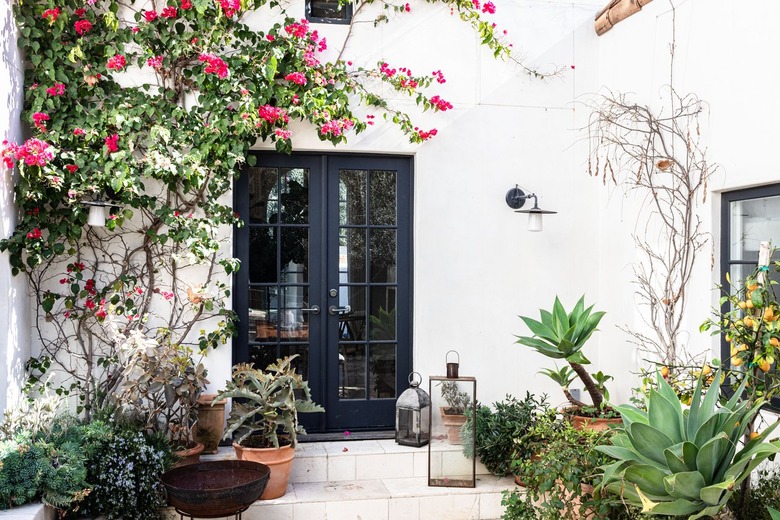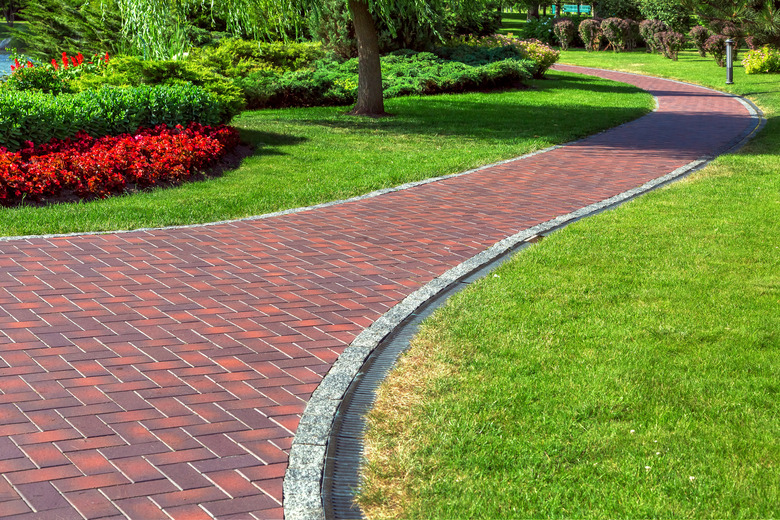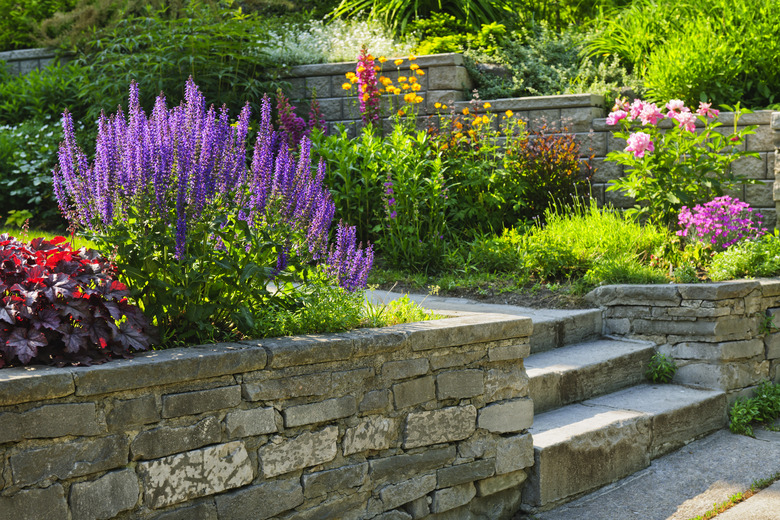A DIY Homeowner's Guide To Hardscape
We may receive a commission on purchases made from links.
By effectively integrating hardscape elements in your landscape design, you can boost your home's curb appeal by its front presentation and also enhance your backyard landscaping theme. Hardscaping offers a stark contrast to the plants in your landscape, providing a point-counterpoint imagery that can be functional as well as aesthetically pleasing. Even if you're not skilled in masonry, woodworking or construction, many hardscape projects are within your reach as a DIY homeowner.
Landscape Design: Hardscape vs. Softscape
Landscape Design: Hardscape vs. Softscape
When you look across your landscape, you see "soft" and "hard" features. Examples of softscapes include trees, shrubs, plants and grass — living things. Examples of hardscapes include driveways, sidewalks, fencing, garden walls and even your home — nonliving things.
Hardscapes turn a landscape into a human-friendly outdoor living space, and UC Master Gardener Program of Sonoma County calls attention to one of the many benefits of hardscapes — the lack of regular maintenance that's required by most softscapes.
Hardscape materials include brick, wood, concrete, flagstones, pebbles, metals and even tree branches, which can form structures such as wattle fences. Softscape often meets hardscape when turfgrass lines a walkway or when a terracotta pot holds a plant. Without hardscapes, landscapes would fall short of having impactful focal points, such as water features, outdoor kitchens, decking, fire pits and pergolas.
Driveway Hardscape Design
Driveway Hardscape Design
The University of Missouri Extension identifies a driveway as one of the two basic residential hardscape components (a walkway is the other one). As a utilitarian hardscaping element, a driveway can help or hinder stormwater runoff after rain events. The cost of labor and materials varies depending on the length and width of a driveway as well as the hardscape materials used. Although concrete is most commonly used for driveways, it's not the only option.
Design ideas for driveways depend in part on the hardscape materials you choose, including:
- Concrete. The two most common types of concrete
driveways are plain poured concrete and stamped concrete. The hardscape materials are
the same, but stamped concrete gives you the option of adding a design
motif with a look that imitates paver stones, tile, inlaid stone or even marble. A standard
poured concrete driveway is moderately priced, with a range from $4 to $7 per square foot, while a stamped concrete driveway ranges from $8 to $15. - Brick. A brick driveway is not only aesthetically
pleasing but it can also contribute to the landscape design principle of rhythm
or repetition, noted by Michigan State University Extension, if it mirrors the brick façade of your home. On the downside, Pacific Pavingstone
notes that brick driveways are susceptible to cracking and breaking. Bricks are
installed on a poured concrete slab and are mortared in place. This
provides three potential sources of cracking and breaking: the bricks themselves, the
mortar that joins them and the concrete foundation. The average cost for a
brick driveway is approximately $30 per square foot. - Pavers. Pavers can look like brick but are made of a concrete-like material that is more durable than natural clay brick. By using interlocking pavers, you can design a driveway with a variety of
options for color, patterns, textures and sizes. If a paver or section of
pavers is damaged, you don't have to remove an entire section of driveway to
repair the damage as you'd have to do with a concrete driveway. Paver driveways can range in cost from $10 to $50 per square foot. - Permeable paving. An environmentally friendly driveway
choice is porous pavement, which has a permeable surface. The Environmental Protection Agency reports that permeable pavement helps reduce stormwater
runoff and filter pollutants that can contaminate groundwater. Two common permeable
paving options are plastic grids and pervious concrete. Interlocking plastic paving grids are laid on a gravel base and then filled with gravel. Pervious (another
word for permeable) concrete looks and feels like conventional concrete, but it
is porous, so it allows water to seep in instead of running off the surface. The cost for
permeable paving ranges from $10 to $30 per square foot.
Path and Walkway Hardscape Design
Path and Walkway Hardscape Design
Walkways not only move people through the landscape but they can also separate a landscape into discrete outdoor rooms or larger outdoor spaces. When designing the entry walk to your front door, you can use the same hardscape material as your driveway, or you can choose a complementary material.
Although both these hardscapes typically are paved surfaces, a walkway may be made of flagstone or stepping stones. Consider the safety of your walkway before choosing hardscape materials. Although flagstones and stepping stones offer a pleasing aesthetic look that guides visitors to your front door, they aren't always as accessible as a smooth, paved surface to people with disabilities.
The University of Missouri Extension sheds light on a common problem that homeowners don't consider when installing a walkway — it's typically too narrow. While most walkways are 3 feet wide, this narrow span means visitors must walk single file. To accommodate two people who want to walk side by side, particularly for guests who need assistance from someone else, the walkway should be at least 4 feet wide, and to welcome guests in wheelchairs, design your walkway with at least a 5 foot width.
Garden Walls and Retaining Walls
Garden Walls and Retaining Walls
Decorative garden walls outline outdoor rooms, guide the eye through a landscape design and hide undesirable views. UC Master Gardener Program of Sonoma County notes that if you want a rustic look in a natural garden setting, you can build a dry-laid (also called dry-stacked) natural stone wall without having any special masonry skills. Simply stack stones to construct the wall. If you want to anchor the wall for a solid look, use mortar to hold bricks or blocks in place.
Retaining walls mitigate erosion; they help shore up slopes to keep soil, mulch and plants from washing downhill. Oregon State University Extension Service notes that you can save money with a DIY retaining wall installation using concrete retaining wall blocks. Landscape timbers are another good option. Keep in mind that homeowner-built retaining walls should not exceed 3 feet in height. Taller walls typically require professional engineering and installation.
Fence and Gate Hardscape Projects
Fence and Gate Hardscape Projects
Fences and gates can offer a measure of privacy and security to your landscape. They can even provide a safety feature — for example, a fence that surrounds your swimming pool that is secured by a locked gate blocks access by curious children and pets. Open fences, such as a split-rail fence, don't obstruct landscape views on the other side. Solid fences, such as a wooden privacy fence, shield homeowners from the view of their neighbors and block access from uninvited visitors.
Depending on the type of fence you want, you'll also want to consider its average life span and maintenance. According to Central Fence Co., wooden fences that are properly maintained may last for 20 years, chain-link fences have a life span up to 30 years and vinyl fences may last up to 40 years.
Although a wooden fence gives a more natural look to any landscape design, you may have to paint, stain or seal it periodically to extend its life. Even though a chain-link fence has a stark, utilitarian look, you can grow flowering or nonflowering vines on it to fill in its open weave, soften its appearance and form a living green screen.
References
- UC Master Gardeners of Butte County: Planning Your Hardscape
- UC Master Gardener Program of Sonoma County: Hardscape
- University of Missouri Extension: Residential Landscaping
- HomeAdvisor: How Much Does a Concrete Driveway Cost?
- HomeAdvisor: How Much Does a Paver Driveway Cost?
- Pacific Pavingstone: Driveway Paving – Comparing Asphalt vs. Brick vs. Concrete
- Michigan State University Extension: Principles of Landscape Design
- U.S. Environmental Protection Agency: Soak Up the Rain – Permeable Pavement
- HomeGuide: How Much Does it Cost to Install Driveway Pavers?
- Oregon State University Extension Service: Building a Landscape Retaining Wall
- Colorado State University Extension: Retaining Walls – Design Considerations
- Central Fence Co.: The Average Lifespan of Your Fence


